There are few things in the music business talked about as much as streaming earnings. When Spotify started in 2008, the ‘all you can eat’ music streaming model was a whole new thing. Artists like Taylor Swift have famously exclaimed they’re not being paid fairly by the streaming service.
On the other hand, the streaming music model has opened a new world of opportunities for independent artists and bands. Playlists and algorithms create new marketing methods and opportunities, accessible to more creators than ever before. In total, the music streaming service has paid more than 31 billion to artists and rights holders, of which more than 5 billion in just the last year!
What does all this mean? How do streaming earnings compare to typical song sales on stores like iTunes? And how much does Spotify really pay artists per stream (in 2022)? Let’s take a look.
How much does Spotify pay per stream?
Of all the money Spotify makes, about 70 percent goes to music rights holders as streaming royalties. This includes money from subscriptions, advertising and other related revenue streams. In 2022, Spotify pays between €0,0026 and €0,0072 per stream, with an average payout of €0,0034 per stream. That means 1000 streams will net you around €3,40, and 100,000 streams about €340.
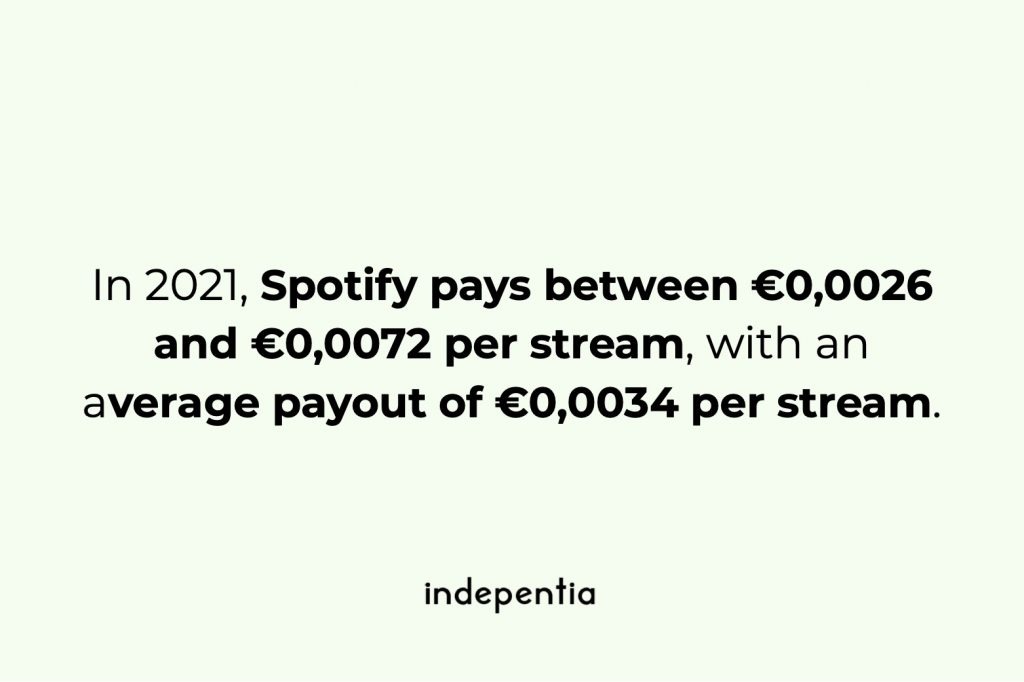
The exact amount you’ll earn per stream can vary and depends on a lot of different factors. For example the type of account which made the play (free or premium), how long the song was listened for, the country of the listener and the agreement with your label or distributor.
Good to know: when you use Indepentia to distribute your music, you receive 100% of your earnings. We never take a percentage, all money we receive for your music goes straight to your account. Other distributors might take a percentage depending on your deal with them.
Spotify streaming royalties calculator
If you are an artist and want to get an estimate as to how much you can earn with streams of your songs, you can use our easy Spotify streaming royalties calculator. Compared to other tools you can find online, ours is much more reliable because it uses real royalty reports as data source.
Enter an expected number of plays for your song, and the royalties calculator will crunch the numbers. It will then show you a range of expected earnings, a minimum and a maximum value. The royalties you’ll receive from Spotify will be somewhere within that range.
You can also find the most recent average revenue for a single stream on the calculator page, so you can check back later and see your estimated earnings changing over time.
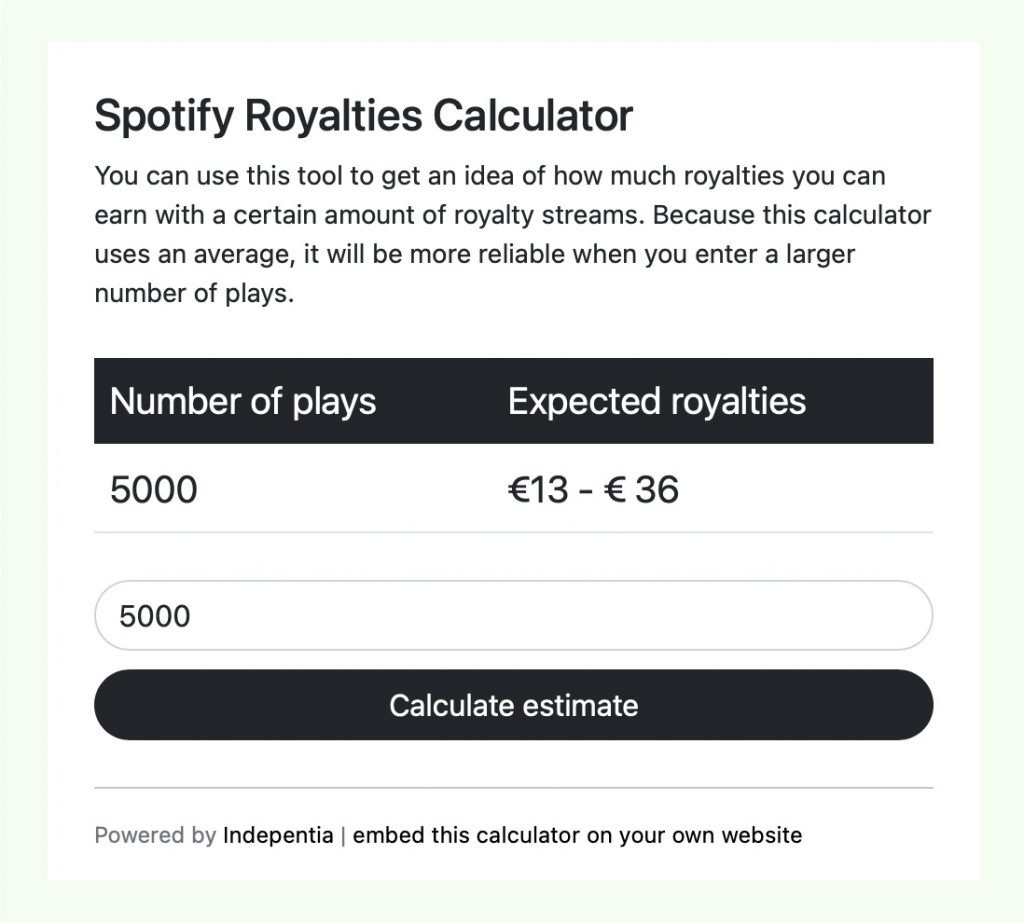
How are Spotify streaming royalties divided?
While rights holders are paid based on the number of streams they receive, streams are not linked to money directly. Instead, all of Spotify’s revenue from subscriptions, advertising and other sources is combined. It then gets split amongst all rights holders based on the amount of streams they receive within a time period. Spotify calls this ‘streamshare‘. Streamshare is an artist’s share of the total amount of streams Spotify delivered within a time period.
For example: if Billie Eilish receives 2% of all Spotify streams in a month, she will receive 2% of that month’s available streaming royalties.
This indirect way of dividing royalties means the money a premium user pays for his subscription also goes to artists he never listens to. That’s why some artists and right holders believe this is the wrong way to divide royalties, and they should be allocated directly based on listening behavior. The current system is less than ideal for indie artists who have just a few very dedicated fans.
What infuences Spotify payout per stream?
The payment per stream is not static and will change over time. This means that you might get paid a certain amount for 1000 streams in January, and much more – or less – in Februari. While Spotify does not disclose every variable that influences your earnings per stream, we do know about a few important ones.
Listener subscription type
One of the biggest factors influencing the value of the pay per stream is the type of subscription an user has. Spotify currently has about 75 million active users, of which 20 million premium subscribers which pay a monthly subscription fee.
Generally speaking, revenue from premium subscriptions is higher than advertising revenue. This means that when a lot of users with a premium subscription listen to your music, the payout per play will be relatively high. If your music is mostly listened to by free accounts, the average payout per stream will be lower.
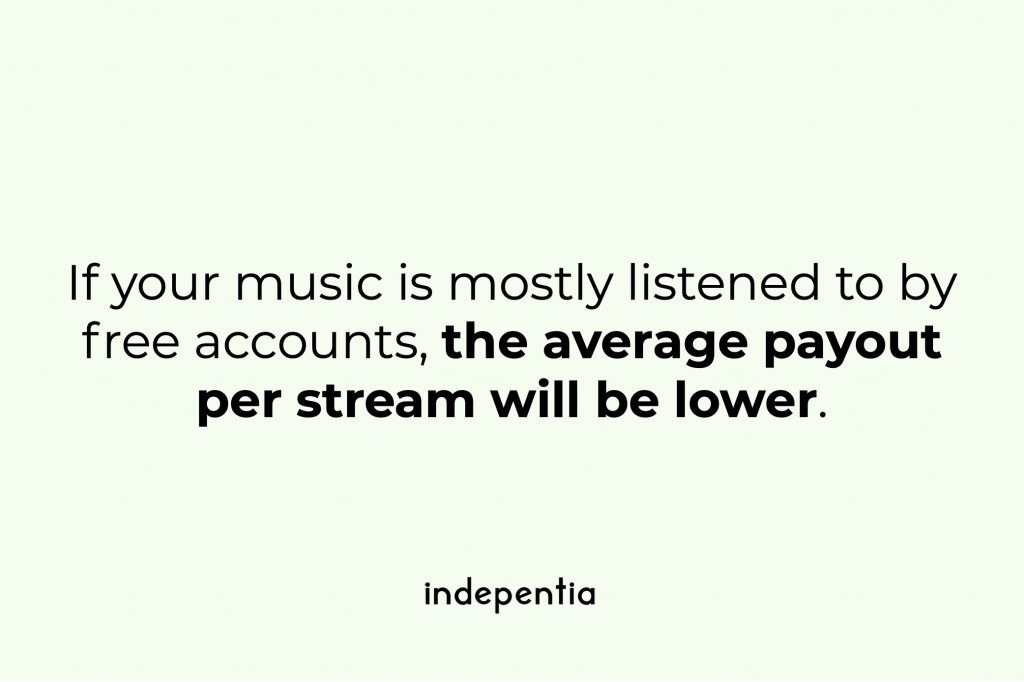
For inde artists, this can actually be an advantage, because subscription rates are high among music lovers who like to look for new, undiscovered music. Casual listeners who only play music in the background are more likely to use a free account.
Listener location
Another big factor influencing the pay per stream is the country of residence of the listener. The value of one stream can vary a lot by country due to currency exchange rates and differences in advertising revenue or premium model pricing.
This means that when your song does very well in one country, your earnings can be higher or lower than a song that’s succesful in another country. If your plays are more uniform around the globe, your earnings will be closer to the average you’ll get from streaming calculators like the one above.
Length of play
To prevent abuse and filter out unintended plays, a track has to be played at least 30 seconds to count as a stream and be elgible for a royalty payment. After those 30 seconds have passed, if a listener restarts the song (or has it on repeat), it will count as another play.
Songs saved offline in an users library count exactly the same as ‘real’ online streaming plays. The Spotify client or app keeps track of how many times a song is played while offline and syncs the play counts when the user connects to the internet again.
Good to know: while it does not influence the royalty rate, user behavior like playing the track in full or skipping before the end can influence the ranking of your songs in the streaming platform. That’s why it’s important to make your track interesting from start to end, and not to leave any silence at the end of the song.
There are many more factors influencing how much you’ll receive per stream, but Spotify does not disclose all of them to prevent abuse of their algorithm.
Who receives Spotify royalties?
It’s important to know streaming services never pay artists direcly. Royalties are paid to rights holders like record labels, distributors (like Indepentia) or aggregators, which in turn then pay the artist.
This extra step also means those intermediaries can keep a part of the artist’s earnings. How much this is depends on your contract with them. Most labels take a big cut to pay for their services like advance payments, promotion and distribution. Many distributors also keep a percentage to pay for audio storage and royalty processing. This is not always immediately clear, so be sure to read through their agreement before you sign up with them.
Indepentia never keeps any of your royalties. We pay the artist every cent we receive for their streams or sales. This is the only right way to do it in our opinion.
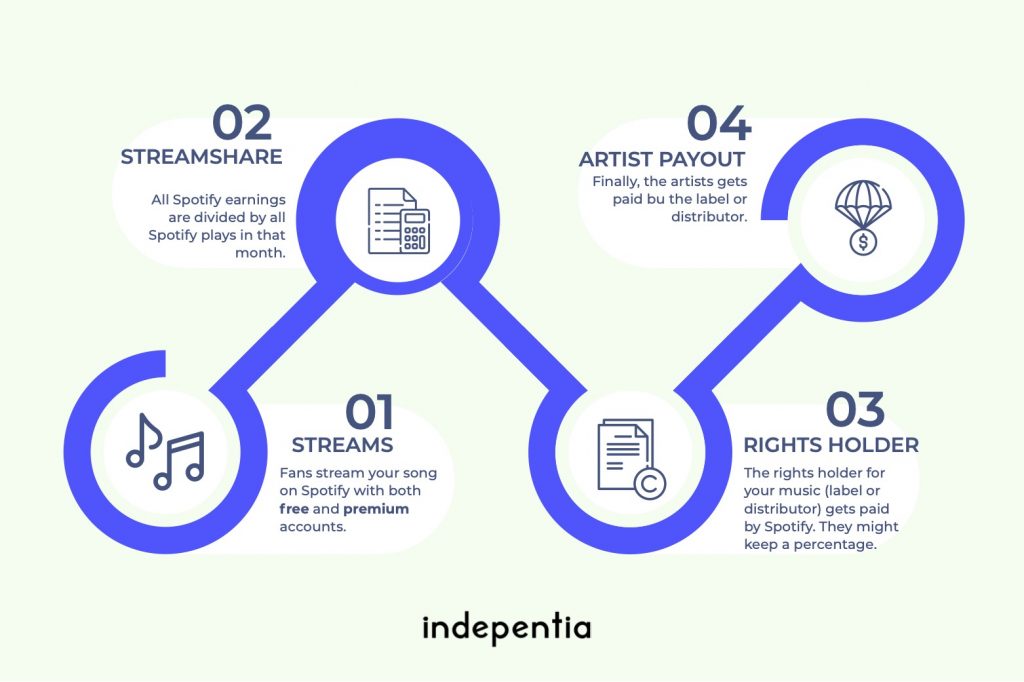
Spotify royalties flow
Can an artist make a living from Spotify streams?
How does all of this compare to real life? Is it feasible to make a living making music and publishing it on Spotify? Let’s calculate..
If you want to get a cheeseburger off the dollar menu, you need about 250 streams. The average Uber ride will cost you about 6500 streams. And to cover a month of rent for an apartment in New York, you’ll need over one million streams. And that’s before taxes.
As you can see, it’s next to impossible to live off Spotify streaming royalties alone. Luckily, for most artists Spotify is not the only source of income but just one extra way to make their music available and easy to access for a wide audience.
It’s also good to remember that streaming services, unlike traditional online music stores like iTunes, don’t just pay once. They pay for each and every stream from your fans. Every stream today, tomorrow, next month and also over the coming years. This means that over time, your streaming revenue will likely overtake your sales revenue. It also allows you to build a steady income that’s much better to predict into the future. There’s no limit to the amount of plays. As long as people are listening, you get paid.
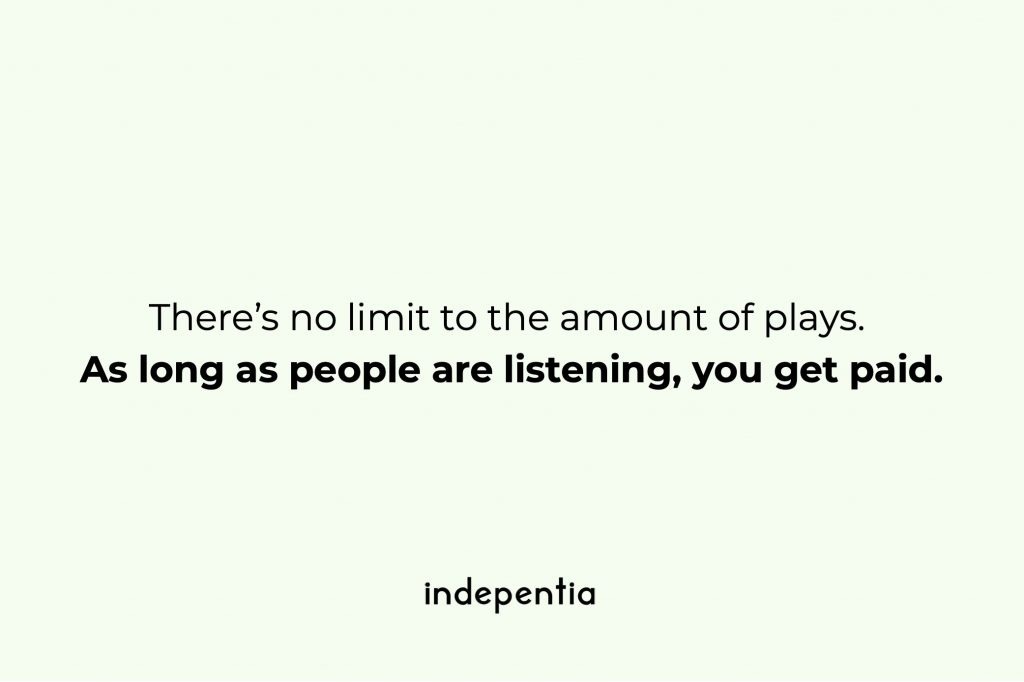
Comparison to other streaming platform royalties
How does the Spotify payment rate per stream compare to other popular streaming services like Apple Music, Amazon music or Tidal? We’ve used our royalty data to generate an average per-stream pay for most services we distribute to. These are averages based on royalty reports data from 2021 and 2022.
As you can see, Napster has the biggest payout per stream by far with around €16 per 1000 streams, over four times the value of Spotify. Lossless streaming platform Tidal (who claim to pay the biggest percentage of earnings to artists) comes in second with about €11 per 1000 plays, or about one cent per play.
Due to the fact that these high-paying services have a much smaller user base, your total monthly payment from these will still generally be lower than from the more popular, lower-paying ones. Simple because the amount of streams you’ll receive from these will be lower. At Indepentia, we see most royalties coming from Spotify with Apple Music being an increasingly close second.
On the low end of the payout list we find Amazon Music with about €3,40 per 1000 plays and YouTube Music, with a measly €0,06 per thousand plays.
It’s important to remember not all music streaming platforms have the same subscription options or an ad-supported version, so this can also influence the royalty rate. The average payout does also not always reflect the expected earnings of an indie artist, because the average can be heavily skewed towards higher-earning artists.
Further reading
Under pressure from rights holders and artists, Spotify is slowly de-mystifying their royalty processes. If you want to learn more about how Spotify’s streaming payments and financials work, take a look at their transparency initiative ‘Loud & Clear‘. The website offers insight into royalty streams and answers any questions you might have about how artists get paid.
If you have any questions about your own royalties, feel free to drop us a line. If your music isn’t yet available on Spotify and you’re ready to upload and start earning your own royalties, create a free Indepentia account.
